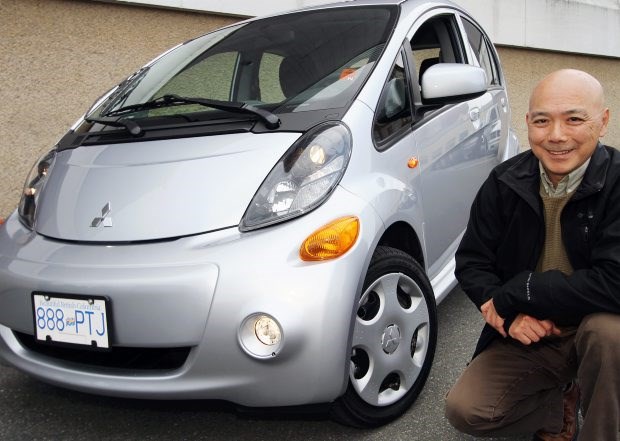Buying an electric car is like taking a leap of faith. But after four months of owning an EV, I still haven't regretted making that decision. In the four months since we launched Plugged In, a microsite on the ÎÚÑ»´«Ã½ web page, a few readers have mentioned the lack of updates on the car itself.
While I have covered a number of topics, from batteries to road taxes, I have hardly talked about my experiences driving the 2012 Mitsubishi i-MiEV.
So here are my observations on living with my car so far:
Mechanical and electrical It has covered approximately 3,500 kilometres, 90 to 95 per cent of that in the city. I have driven the car to "empty" twice, something the manufacturer recommends drivers do at least once a year to reset the battery's memory.
As expected, the range is greatest when the car is driven sedately on routes with few hills.
It does gobble up the energy bars on the fuel gauge quickly on highways and hills.
I have taken the car to 130 kilometres per hour once just to confirm it could do it. It feels OK, but I wouldn't want to spend much time at that speed. It feels most comfortable at between 80 and 90 km/h.
It has a tall body, so when a transport truck barrels past on the highway, or in high winds, the body gets blown about a bit.
The batteries are located under the floor, which gives the i-MiEV a surprisingly low centre of gravity, despite the tall body. Taking corners at speed is actually fun.
The electric motor has proved to be the most entertaining part of the car - for an economy car, this little guy can really hustle. I don't have a stopwatch, but I will put the MiEV against any subcompact at a stop light. Torque is instantaneous.
Because it has an electric motor, there are no gears in the transmission. It's just a single speed and will spin as much as the engine has power. So no transmission whine, changing gears or a fun-robbing continuously variable transmission to contend with.
Theoretically, the MiEV can go as fast backwards as forwards. In reality, the engineers have programmed a limit to how fast I can reverse down a street. As a fan of watching cars race backwards, I am deeply disappointed, but I understand there are those out there who would abuse this.
Of late, I sometimes get a soft "clunk" when I move the transmission into Park. I intend to get this looked at at my first service.
Car body
It rains around here - hard sometimes. In the MiEV, you know it's raining not just by drops on the windshield, but by the rattat-tat on the roof. I seriously don't think Mitsubishi put any sort of insulation in the roof of the MiEV.
An owner from Russia remarked that it was hard to keep the car warm in the winter, so I don't think we were singled out. A wee bit more insulation in the doors and firewall would probably help keep the road noise down. An EV, by nature, is completely silent, so occupants are more aware of tire and road noise.
More insulation would probably make the doors sound less tinny when closed, as well. I don't expect a thunk, but the current sound doesn't inspire confidence should another car hit it.
I drive the base MiEV, so hard plastic throughout the cabin is a fact of life. I still don't regret not ordering the deluxe package, which includes some fabric on the doors and a navigation system with back-up camera for $3,000.
I do miss a cargo cover, which is not available, even as an accessory.
The car has two wipers, but only one windshield-washer-fluid outlet attached to the primary (driver's side) wiper. This means the secondary wiper just smears the dirt around. The engineer who forgot to place the washer outlet on the second wiper should be sent back to school.
The problem only turns up in North American cars. In the rest of the world, the i-MiEV is narrower and is only equipped with one wiper. When they widened the cars for the U.S. and Canadian market, they merely stuck another wiper to adequately cover the extra glass area. But nobody thought to add an extra washer outlet. An oversight that reduces sight.
Instrumentation
The instrumentation display only offers one field at a time. If I want to know distance travelled and distance to empty, I have to scroll through the menu, outsidetemperature screen, instrumentpanel light-adjustment screen, time-until-next-service screen, etc. It's time-consuming and frustrating.
To add insult to injury, the small button you need to continually push is located on the dash, which forces the driver to reach around the steering wheel to depress it.
Almost every other manufacturer has two or three displays up simultaneously and a scroll button on the steering wheel or other more convenient position on the dash. Some can even scroll forwards and backwards.
As far as leaps of faith go, purchasing an electric car has proven quite painless. In 3,500 kilometres and four months of ownership, I have used approximately $52.50 in electricity (I calculated it at 1.5 cents per kilometre). The bonus is zero emissions - notwithstanding the continuing debate on how electricity is generated in the province.
At this rate, my annual cost to run the i-MiEV will be approximately $157.
Follow me on Twitter: @pedrothecarguy EV Microsite: timescolonist.com/pluggedin



